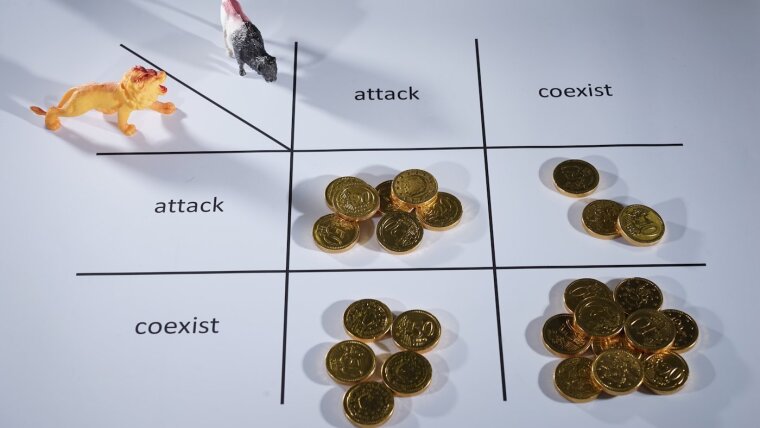
-
Schuster, Stefan, Univ.-Prof. Dr Professorship of Bioinformatics
Room 3013
Inselplatz 5
07743 Jena -
Dwivedi, Shalu Professorship of Bioinformatics
Room 2008
Inselplatz 5
07743 Jena
Image: Suman Chakraborty -
Malycheva, Tatiana Professorship of Bioinformatics
Room 2007
Inselplatz 5
07743 Jena
Image: Fotostudio Müller -
Korn, Lukas Professorship of Bioinformatics
Room 2007
Inselplatz 5
07743 Jena
Mathematical Modeling of Host-Pathogen Interactions
-
Project description
The polymorphic yeast Candida albicans and the filamentous fungus Aspergillus fumigatus are the most important life-threatening human pathogenic fungi. Both fungi have developed multiple strategies to attack and evade the human immune system. Using evolutionary game theory and dynamic optimization we analyze the struggle between these fungi and the human immune system. For this we study payoff matrices in view of aggressive strategies versus peaceful coexistence. In an additional study we are using a dynamic population model to under stand the characteristics of an optimal immune response during a fungal infection.
-
Literature
- S. Dwivedi, R. Garde, S. Schuster
How hosts and pathogens choose the strengths of defense and counter-defense. A game-theoretical view
Front. Ecol. Evol. 12, January, 2025, 1379868 - S. Dühring, S. Schuster
Studying mixed-species biofilms of Candida albicans and Staphylococcus aureus using Evolutionary Game Theory
PLOS One 19(3), 2024, e0297307 - J. Ewald, P. Sieber, R. Garde, S.N. Lang, S. Schuster, B. Ibrahim
Trends in mathematical modeling of host-pathogen interactions
Cell. Mol. Life Sci., 77 (2020) 467–480 - S. Dühring, J. Ewald, S. Germerodt, C. Kaleta, T. Dandekar and S. Schuster
Modelling the host–pathogen interactions of macrophages and Candida albicans using Game Theory and dynamic optimization
Journal of The Royal Society Interface 14 (132), 2017, 20170095K. - Czakai, M. Dittrich, M. Kaltdorf, T. Müller, S. Krappmann, A. Schedler, M. Bonin, S. Dühring, S. Schuster, C. Speth, G. Rambach, H. Einsele, T. Dandekar, J. Löffler
Influence of platelet-rich plasma on the immune response of human monocyte-derived dendritic cells and macrophages simulated with Aspergillus fumigatus
International Journal of Medical Microbiology 307 (2), 2017, 95–107 - S. Dühring, S. Germerodt, C. Skerka, P. F. Zipfel, T. Dandekar, S. Schuster
Host-pathogen interactions between the human innate immune system and Candida albicans - Understanding and modeling defense and evasion strategies
Frontiers in Microbiology 6 (625), 2015, https://doi.org/10.3389/fmicb.2015.00625External link
- S. Dwivedi, R. Garde, S. Schuster
-
Funding
DFG Collaborative Research Center / Transregio 124 "FungiNet"
Agent-based modelling of microbial interactions
-
Project description
The modelling of microbial interactions in spatially complex environments often poses a challenge for equationbased modelling attempts. Therefore we instead try to use agentbased modelling to generate insights in such systems. For this we collaborate closely with experimental groups in a combination of experimental work and computational simulations to identify the relevant aspects of the microbial interactions in question. I one collaboration we for example investigate the cycles of iron respiration through the bacteria Sideroxydans and Shewanella. Key questions within this context are the identification of optimal strategies for an efficient iron throughput within the cycle and the influence of environmental factors, e. g. the oxygen concentration.
-
Literature
- Andre Then, Jan Ewald, Natalie Söllner, Rebecca E. Cooper, Kirsten Küsel, Bashar Ibrahim, Stefan Schuster
Agent-based modeling of iron cycling bacteria provides a framework for testing alternative environmental conditions and modes of action
Royal Society Open Science 9, 2022, 211553 - S. Germerodt, K. Bohl, A. Lück, S. Pande, A. Schröter, C. Kaleta, S. Schuster, C. Kost: Pervasive Selection for Cooperative Cross-Feeding in Bacterial Communities, PLOS Computational Biology 12 (2016) e1004986
- C. Tokarski, S. Hummert, F. Mech, M.T. Figge, S. Germerodt, A. Schroeter, S. Schuster: Agent-based modeling approach of immune defense against spores of opportunistic human pathogenic fungi, Frontiers in Microbial Immunology 3 (2012) 129
- Andre Then, Jan Ewald, Natalie Söllner, Rebecca E. Cooper, Kirsten Küsel, Bashar Ibrahim, Stefan Schuster
-
Funding
Collaborative Research Center 1127 - Chemical mediators in complex biosystems (ChemBioSys)
Defense and Counter Defense
-
Project description
Many interactions in nature involve various defense mechanisms. To bypass these mechanisms, there are several counter defense techniques. Examples are provided by beta-lactam antibiotics produced by several fungi and Streptomycetes and, as a counter-adaptation, beta-lactamases (which open the beta-lactam ring) produced by several bacteria.
Another example can be found in Brassicaceae plants, which defend themselves by glucosinolates (GLSs). The stored GLSs are not yet toxic but are hydrolysed by plant myrosinases to isothiocyanates upon herbivory or tissue damage. Specialist herbivores of Brassicaceae have evolved specific counter-defenses. Some of them block myrosinases while others redirect the hydrolysis to form less toxic products (like nitriles).
Many organisms produce not a single defense chemical, but a mixture of them. An example is tea tree oil produced by a plant Melaleuca alternifolia. It is a mixture of multiple terpens and has a potent antimicrobial activity. Some bacteria, for example, Pseudomonas aeruginosa can transport these terpens out of the cell using efflux pumps. This mechanism is an effective counter-defense against all the mixture components.
But everything comes at a price – the counter-defenses imply metabolic costs. Thus, the question arises whether it is always beneficial. Moreover, it is not clear why specialist herbivores primarily choose a toxic habitat where they have to invest into detoxification. It is also open to debate what the benefits of defense chemical mixtures are over the specific defense chemicals.
We use game theory, modeling by differential equations and dynamic optimization to describe and explain such phenomena.
-
Literature
- S. Dwivedi, R. Garde, S. Schuster
How hosts and pathogens choose the strengths of defense and counter-defense. A game-theoretical view
Front. Ecol. Evol. 12, January, 2025, 1379868 - S. Chakraborty, S. Dwivedi, S. Schuster
Mathematical modeling predicts that endemics by generalist insects are eradicated if nearly all plants produce constitutive defense
Sci. Rep. 14, 2024, 25771 - S. Chakraborty and S. Schuster
How plant toxins cause early larval mortality in herbivorous insects: An explanation by modeling the net energy curve
Toxins 16, 2024, 72 - S. Chakraborty, J. Gershenzon, S. Schuster
Selection pressure by specialist and generalist insect herbivores leads to optimal constitutive plant defense. A mathematical model
Ecology and Evolution 13, 2023, e10763 - S. Chakraborty, J. Gershenzon, S. Schuster
Comparing two strategies of counter-defense against plant toxins: A modeling study on plant-herbivore interactions
Front. Ecol. Evol. 11, 2023, 1197757 - S. Schuster, J. Ewald, T. Dandekar, S. Dühring
Optimizing defence, counter-defence and counter-counter defence in parasitic and trophic interactions - A modelling study
arXiv:1907.04820, 2019
- S. Dwivedi, R. Garde, S. Schuster
-
Funding
International Max Planck Research School (IMPRS)